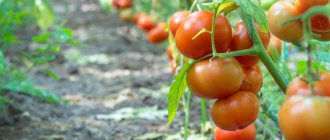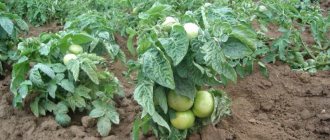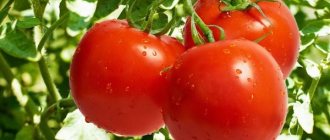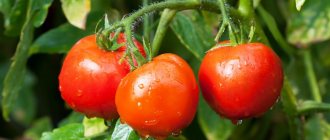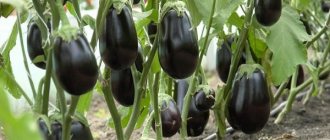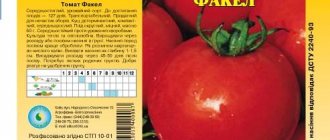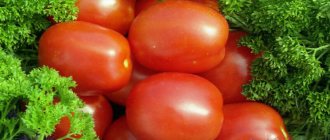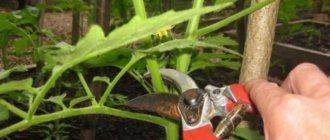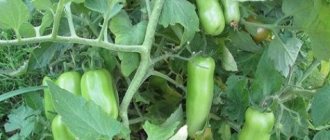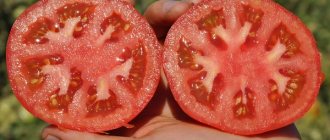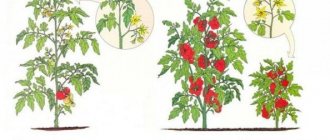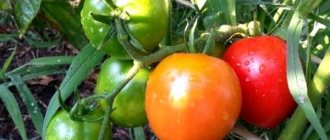Gardeners are increasingly planting tomato varieties on their plots. Most of these plants are intended for planting indoors. They were bred to be grown on a large scale for industrial purposes. But ordinary summer residents also loved them.
The distinctive quality of these tomatoes is that their fruits ripen almost simultaneously. They form a kind of bunch with many tomatoes and are very decorative.
Carpal varieties have a number of advantages:
- high productivity;
- good gastronomic qualities;
- ripened tomatoes do not rot or fall off;
- can be collected in bunches.
Seeds are planted for seedlings. Sowing time depends on climatic conditions.
Among the raceme tomatoes there are indeterminate (tall) and determinate (short) plants. Indeterminate bushes are formed leaving one main stem. Determinate - in several stems. Tall bushes need to be tied to a trellis or stakes.
The brush of such tomatoes can be simple, intermediate, complex or very complex. There are very few plants with a complex raceme. One bunch can consist of 30-100 tomatoes.
According to the ripening period, tomatoes can be:
- ultra early ripening 80-85 days;
- early ripening 90-95 days;
- mid-season 100-115 days;
- late ripening 120-130 days.
For areas with a temperate climate, early varieties are better suited. Late-ripening ones can be planted only in the south of Russia, or in greenhouses with additional heating.
Hybrids are considered the best cultivar tomatoes. These tomatoes require a lot of attention. They are high-yielding, the fruits are beautiful, smooth, with shiny skin, transportable, and not susceptible to diseases. In terms of taste, hybrids are not inferior to other varieties. Well kept.
Hybrids are obtained by crossing two species. They are designated by the letter F1 (first generation), obtained by crossing. Hybridization is complex, long manual labor. The seeds of such plants are more expensive.
Specific characteristic
Previously, gardeners also grew so-called cluster tomatoes. But the fruits on them did not ripen at the same time, and also, their size was not the same. After breeders began transforming such varieties, it became possible to pick ripe, juicy fruits at the same time, along with a dense brush that securely holds the tomatoes even during transportation.
The varieties of grape tomatoes cultivated today can be described as follows:
- Tomatoes on a bunch ripen almost simultaneously. After the lowermost fruits ripen, the upper ones still retain their presentation and do not lose their taste. A ripe brush can remain on the bush for about a month without reaching the stage of overripeness.
- The tomatoes are tightly attached to the branch. They can be collected together with a brush, and even light shaking and transportation over fairly long distances does not cause damage to the stalk. You can be sure that all the tomatoes will remain on the bunch.
- Tomatoes are the same size on the same bunch. If their size were different, the overall appearance would suffer, which affects their cost.
- Resistance to creases allows you to be sure during fruit filling that the clusters will be intact and the fruits will ripen successfully in the garden.
- Carpal varieties of tomatoes are distinguished by their ability to reliably resist cracking of fruits, despite unsuitable weather conditions or insufficient care for them.
In addition, the hybrids created by breeders are characterized by increased productivity, resistance to many types of diseases and pests of tomatoes, as well as early ripening. Another positive feature of such vegetables is that they do not require frequent fruit picking.
Advantages of greenhouse tomato cultivation
Typically, raceme tomatoes are grown in a greenhouse; only some varieties can be grown in the ground, and even those only in the south. Of course, growing tomatoes in greenhouses has a number of disadvantages, but there are also advantages:
- It is easier to fight diseases and pests in a greenhouse; drugs act more effectively in closed ground conditions;
- You can exercise full control over the growing conditions. In a greenhouse we are less dependent on weather conditions;
- Good greenhouses usually allow for two crops;
- Tall indeterminate tomatoes are best grown in greenhouses - it is easier to tie them up there, and there is no danger that strong winds or an animal will break the fragile stem.
This is especially important for the northern regions, where even early-ripening, low-growing tomatoes do not always have time to ripen in open ground.
Advantage of raceme tomatoes
As a rule, grape tomatoes for greenhouses can also be grown in open areas in the southern regions without compromising their quality. Of course, the greenhouse growing method also has some disadvantages, but there are still many advantages:
- indoors it is easier to fight pests and plant diseases, and the effect of the drugs is more intense;
- you don’t have to worry about the vagaries of nature,
- in a greenhouse it is easier to control growing conditions;
- This method of cultivation will allow you to harvest up to two harvests per year;
- Since hybrids are characterized by tall bushes, in greenhouse conditions it is easier to care for them and protect fragile stems from gusts of wind or animals.
Growing in a greenhouse is quite favorable for server areas, where even early varieties with low-growing bushes do not have time to ripen in open areas.
See also
Which tomato varieties are best suited for the Moscow regionRead
Small-fruited tomatoes
Lovers of small tomatoes should grow small-fruited tomato varieties.
Mandarin duck
This variety is suitable for people who plan to grow early-ripening tomatoes in the garden. Mandarin fruits will ripen two months after planting in the soil. The advantages of the variety include a pleasant taste, resistance to cold and a high level of yield.
Mandarin duck differs from other small-fruited vegetables in its fruits, which are colored bright orange. A harvest of 5-8 kilograms is harvested from each bush.
Potted orange
An early-ripening super-determinate plant, the height of which does not exceed twenty centimeters. The compactness of the bushes allows them to be grown in small pots. Tomato fruits are also small and weigh only 30-40 grams. They are used when preparing preserves and creating vegetable salads.
See also
Useful properties of hydrogen peroxide for tomato seedlings and application
Read
Monisto chocolate
Indeterminate vegetable with tall bushes 2-3 meters high. The bush does not need to be pinched, as it independently forms into one stem. When grown on seedlings, small clusters appear, which can contain 15-25 small tomatoes weighing 35 grams. They have a pleasant sweetish taste that is a bit like the taste of plums.
Features of tomato hybrids
Although in the southern regions tomatoes grow well in open areas, hybrid varieties of tomatoes planted for greenhouses can provide a fairly early or, conversely, very late harvest. In the northern regions the situation is somewhat different. If weather conditions fluctuate, characterized by a sharp drop in temperature, cloudiness, this will also adversely affect the growth of greenhouse plants.
Such vagaries of nature will not bother gardeners if the tomato growing facility is equipped with heating and reliable electric lighting. But such costs during cultivation can significantly increase their cost. Therefore, the best varieties are considered to be those that can bear fruit even in low light conditions or with significant fluctuations in temperature.
As a rule, tomato varieties bred for southern latitudes are not suitable for northern climates. But one should not assume that under no circumstances will tomatoes of this series be grown there. But northern tomatoes in southern latitudes will not be able to produce a miracle harvest. Most likely, the harvest will not be obtained at all. Because plants grown in cool climates simply cannot survive hot days.
Remember! When choosing tomato hybrids for growing, carefully read the label on the package. They may be written: “heat-resistant”, “resistant to low temperatures”, and also “resistant to low light”.
Of the main varieties of raceme tomatoes, zoned mainly in cold climates, the best varieties of these vegetables described below can be distinguished.
Features of raceme tomatoes
Carpal tomatoes are those whose fruits can be collected in whole clusters. In clusters, the fruits fill and ripen at the same time, do not overripe or crack. Ripe fruits on a branch look very impressive. At the same time, raceme tomatoes are distinguished by very high quality fruits, and the plants themselves are unpretentious, resistant to diseases and have a genetically inherent increased productivity. The combination of all these factors determines the popularity of these tomatoes among summer residents.
In general, raceme tomatoes have small fruit sizes and thick skin, so they can be used for preservation and fresh. The preparations made from them are very tasty and beautiful.
The fruits of raceme tomatoes are stored well even without special conditions. To extend the period of consumption of tomatoes, the brushes can be cut off at the moment when the first 2-3 fruits in the “bunch” turn red. After 4 - 5 days, the rest of the tomatoes in the bunch will turn red.
These tomatoes tolerate transportation well, which is why they are in great demand when growing tomatoes for sale.
Like other raceme tomatoes, they are divided into indeterminate and determinate.
As a rule, raceme tomatoes are grown in greenhouses. Most of these are indeterminate plants (unlimited growth) that need to be shaped. A small number of varieties of brush tomatoes can be grown in open ground.
We will tell you about the best varieties of grape tomatoes for greenhouses and open ground in this article.
True friends f1
A tomato variety of Siberian selection has a fairly early ripening period. Bushes can reach two meters in height. The tomatoes are round in shape, scarlet in color, and have a firm consistency. The weight of the fetus usually reaches 100 g.
As a rule, up to 12 fruits of equal size are poured onto such a brush, ripening at the same time. High-yielding species. From each plant it is possible to harvest 9 kg of tomatoes. Used for preservation. Temperature changes do not have a negative effect. It has a positive characteristic of tomatoes for open ground when planted in cool climatic zones.
Tomato Yenisei - description and characteristics of the variety
The Yenisei tomato is a tall plant with large fruits. This is a semi-determinate variety, meaning the plant stops growing when 10 to 12 flower clusters are formed, their placement observed every two or three missing leaves.
How to grow
The Yenisei tomato must be grown using seedlings. To begin with, the seeds need to be placed in an aloe solution for a short time, and then sown in the soil to a depth of one centimeter. When sowing is complete, it is necessary to water the seeds every day with warm water from melted snow or rain (optional, but desirable) and after watering, cover the area with film until the first sprout appears. In order for growth to proceed steadily, you need to sometimes add compost extract.
The Yenisei tomato loves light, so using fluorescent lamps you can speed up plant growth. When two leaves of the seed appear, they need to be planted in different peat vessels. All these actions will help protect the roots of the tomato from various injuries. Planting seedlings can begin in the first ten days of the last month of spring, the order of their placement is like in chess.
According to the research and practice of gardeners, the best fruitfulness of the Elisha tomato is established when the bush matures into one or two stems.
How to care
For good growth and harvest, the following care conditions must be met:
Mandatory loosening of the soil. This must be done carefully so as not to injure the roots.
Loosening the soil allows them to breathe oxygen, and this has a good effect on the growth of tomatoes. Hoeing removes weeds, and removing noxious weeds is another important maintenance activity as they interfere with plant growth. Water daily with warm water. Feeding tomatoes with complex mineral fertilizers will help growth and improve the quality of the plant. If you follow these simple rules, then the best and most delicious tomatoes will be on the table. So, from one bush you can collect from five to six kilograms, and from two, in general, from ten to twelve.
Plant characteristics
The fruits of the Yenisei tomato are quite smooth and round, ripen up to 500 grams, the color is bright red, distributed evenly throughout the fruit, the skin is strong and does not crack. And the most important thing is the taste, it is very delicate and soft, slightly sweet and slightly sour, which is good, because the flavors are harmoniously combined. You can eat it straight from the garden, but it’s better to wash it first. In general, the fruits are good to eat both fresh and canned.
Intuition f1
This is an excellent raceme variety with good yield, early ripening - after sprouting the seedlings before harvesting the ripened fruits, the interval is about 110 days. Tomatoes are spherical in shape, with an average weight of up to 100 g. Designed to be collected with a brush. It has excellent flavor notes similar to the Dutch hybrid varieties. They can withstand transportation and do not crack when ripe. Used for cultivation in the regions of the North. It is resistant to changes in climatic conditions and nightshade diseases.
Characteristics and description of Japanese tomatoes
Growing Japanese tomatoes is a very interesting and entertaining activity. Today, every owner of a plot of land can choose a variety that is suitable for certain characteristics. Some of the foreign hybrids have low growth rates and can be grown in a room or on a balcony. Others are intended only for street landing.
For a novice gardener, a large assortment of “Japanese” products can frighten, confuse and mislead. Tomato varieties recommended by sellers do not always meet the requirements that consumers expect from them. Therefore, experts recommend that you first familiarize yourself and thoroughly study the “new product” on the domestic market before making your choice.
Japanese Crab
The popularity of the Japanese Crab tomato is caused by the taste of its fruit. This tomato is very sweet, its flesh is dense and has almost no seeds. This description of the vegetable makes it ideal for preparing cold appetizers. In addition, the connection between the name of the variety and the vegetable itself is also interesting. The fact is that the shape of a tomato resembles a crab, since the fruit of this hybrid is slightly flattened and has noticeable protrusions on top.
Domestic gardeners who grow this Japanese tomato variety highlight the following features:
- This tomato bush is tall. The height of the stem, with proper care, can reach 160-170 cm.
- This "Japanese" has large thick green leaves. But the impressive landscaping doesn't overshadow the clusters of pink tomatoes.
- Productivity is high and long lasting. When grown in a greenhouse, you can have a good supply for the winter, because this variety actively produces crops until mid-autumn.
- Resistant immunity to diseases and pests. With proper care, the risk of rot, tobacco mosaic and other diseases is minimal.
A person who decides to plant this hybrid on his plot of land must go through the standard period of growing seedlings from seeds and planting them. You should not start sowing in open ground right away, because the chances of seedlings appearing are minimal.
Japanese Truffle
The fruits of this variety can change their color
Characteristics of the Japanese Truffle tomato is its advantage. The fact is that the fruits of this plant, in addition to their amazing taste, can change their color depending on the duration of ripening. So, a tomato that has set on a bunch may be pink, but after a few days it will turn bright red. In addition, when overripe, such a tomato turns black.
The description of this variety also has its own characteristics. The bush of this hybrid is vigorous, with dense landscaping. The fruits are shaped like a pear. Their pulp is dense, with a minimal number of seed chambers. The skin is not susceptible to cracking. These qualities of tomatoes make them suitable for transportation and long-term storage.
Japanese creeping
The description of the Japanese creeping tomato makes this variety unlike other varieties of tomatoes. Of the “Japanese”, this is the shortest tomato. Its peculiarity is associated with the size of the shoots, which spread 60-70 cm wide. The height of such a bush is small and rarely exceeds 25 cm in height.
Numerous reviews about this hybrid are related to its appearance during the flowering period. The fact is that its flowers are bright yellow. Flowers, like golden decorations, decorate a spreading green bush
In addition, the fruit ovaries that form later also attract attention. Small bunches of red tomatoes, weighing no more than 100 grams, resemble in their appearance the world-famous Cherry tomatoes.
In addition, these mini tomatoes are great for canning.
Senkara
No less popular in Russia and neighboring countries are the varieties “Senkara” or “Japanese Rose”. These hybrids have average height. They require molding into 1-2 stems when grown in open ground or in a greenhouse. The fruit cluster of the Senkara variety has impressive size and weight. A “bunch” of large pink tomatoes, weighing 250-280 grams, will ripen by mid-June. The indicators of the Japanese rose are more modest. The cluster of this hybrid includes 5-6 bright red tomatoes, weighing no more than 140 grams.
Chisato
The hybrid "Tisato" deserves special attention. Among the people, such a tomato deservedly received the title of giant. The fact is that this powerful plant actively grows and bears fruit in any climatic conditions. The only thing this “Japanese” doesn’t like is frost. The variety gives a good harvest on any soil, despite rainy or hot summers. From one bush you can collect up to 10 kg of fruit. In addition, the brush can only hold 5-6 tomatoes, weighing 250-280 g.
Carpal f1
It is characterized by high productivity and rapid ripening. The ovaries are formed on long racemes. During ripeness, the fruits turn red. They are of a regular round shape. Quite dense. Perfectly stored when cutting along with brushes. Its fruit can weigh up to 110 g. Ideal for canning.
The ovary is formed even with insufficient light flux. Tolerates low temperatures well. Suitable for northern regions.
See also
The best and most productive tomato varieties for Belarus in greenhouses and open groundRead
Large-fruited
Some gardeners prefer to grow tomatoes with large fruits. To choose the best large-fruited tomatoes, you need to become more familiar with these varieties.
Red red F1
An indeterminate productive hybrid that is grown both outdoors and in greenhouses. A distinctive feature of the tomato is considered to be good yield, thanks to which 10-15 kilograms of tomatoes are obtained per square meter of the garden per season. Each fruit weighs 200-300 grams.
Maryina Roshcha F1
A plant with powerful stems that do not need tying to supports. The variety needs to be planted in greenhouses, since outside the bushes are often attacked by pests. The fruits of Maryina Roshcha are round in shape with a small spout at the tip. With good care, their weight reaches 250 grams.
Martez F1
People who prefer to grow tomatoes in film shelters often plant Martez F1. Among the advantages of the plant are its productivity, resistance to pests and many pathologies. Red tomatoes are oval in shape and weigh 200-250 grams.
Spasskaya Tower F1
Fans of large-fruited varieties often grow Spasskaya Tower in their gardens. It is a determinate plant that grows up to one meter in height. A month and a half after planting, clusters with reddish fruits weighing up to 550 grams appear on the bushes. They have a sweetish taste and a pleasant smell.
Red star f1
Early ripe tomatoes. This hybrid species has increased productivity. It has very large fruits for a raceme variety. Each can reach 110 g. The inner part is dense, has increased taste, and noticeable sugar content. Can be canned, processed and consumed raw.
It is resistant to infection by blossom end rot. Shows decent yield even with little care. It grows and bears fruit in many climatic zones, including the northern regions of Siberia.
Tomatoes for greenhouses
Not all cluster tomatoes are suitable for planting in greenhouses. There are several varieties that can be grown in greenhouses.
Money bag
The plant is classified as an early-ripening greenhouse vegetable that ripens within a hundred days. The advantages of Money Bag include a high level of germination and resistance to late blight. The fruits of the vegetable have a perfectly round shape. Most often they are used in canning and creating vegetable salads.
Kasadi's Madness
Another common greenhouse vegetable is Kasadi's Folly. This is a productive tomato that, with proper care, grows up to one and a half meters. When growing a variety, you will have to deal with the formation of bushes so that they bear fruit better. Tomatoes have an oblong shape. The average weight is 150-250 grams.
Jalpa
A vegetable with standard bushes that do not need pinching or tying, since their height is only 40-45 centimeters. The fruits are collected in clusters of six pieces.
The fruits have an oblong shape, which makes them look similar to bell peppers. Distinctive features of ripe tomatoes are their transportability and resistance to peel cracking.
Red star F1
Some gardeners choose Red Star for growing in film greenhouses. This cluster hybrid has juicy and fleshy tomatoes weighing 85-95 grams. Red star is grown to create tomato juice, ketchup and for use raw.
Red red f1
Hybrid variety of early fruit ripening. Bushes should be formed with one main stem. Quite tall. One cluster has 5 - 7 fruits, each weighing 200 - 500 g. They have tasty pulp with pronounced graininess. From a bush of this variety you can harvest up to 8 kg of tomatoes. It is resistant to typical diseases of this type of vegetable. Fruits even in unfavorable weather conditions.
Cultivation Recommendations
The best yield indicator is obtained when using seedling planting techniques. Strong sprouts require compliance with simple rules of agricultural technology:
- Plant seeds 1–2 centimeters deep.
- Organization of separate containers for each bush.
- Maintaining air temperature from 21 degrees.
- Picking when two leaves appear.
- Moistening the soil with water at room temperature.
- Good illumination of the room, daylight hours from 16 hours.
- Preliminary hardening of seedlings before planting.
Caring for a tomato consists of following the standard rules for tall varieties of tomatoes. You should water it on time, remove weeds, loosen and feed the bushes. Inert tomatoes should be tied up and the brushes should be supported with supports. It is advisable to use high greenhouses.
The Carpal hybrid is best grown in seedlings. Seeds are placed in a container with the prepared soil mixture to a depth of 1 cm. The soil is lightly compacted and watered with warm water using a sprayer.
The container is covered with film until the seeds hatch. For the friendly appearance and normal development of sprouts, ensure a temperature of at least 21°C. Seedlings require a light regime, so fluorescent lamps are used to extend the day.
In the phase of formation of 1-2 true leaves, plants are picked into separate containers. For this purpose, it is better to use peat pots, with which you can plant bushes directly into the ground.
Before planting in a permanent place, the seedlings are hardened off for 7-10 days. To ensure high productivity of the hybrid, complex fertilizers are periodically applied according to the manufacturer’s scheme.
The Kistevoy variety needs special watering, which is carried out only after sunset. Warm water is applied at the root. To regulate the balance of moisture and air in the soil, loosening and hilling are carried out.
To ensure even distribution of moisture, it is recommended to mulch the soil using non-woven black fiber. Using last year's grass and straw as mulch serves as an additional source of organic nutrition for the crop.
A tall crop requires tying to a trellis or support. When planting per 1 m², it is recommended to plant no more than 3 bushes to provide each plant with sufficient space.
Maryina Roshcha f1
A hybrid of Siberian selection with stable yields and early fruit ripening. It has increased fertility. Brushes can have up to 9 tomatoes. One tomato can weigh 170 g. A distinctive feature is the simultaneous ripening of the fruit. Used for preservation. Retains its presentation during transportation. During the season you can harvest up to 20 kg of tomatoes of this variety from 1 sq. m.
Resistant to some types of diseases. Such plantings perfectly adapt to weather conditions even in northern climate zones.
Planting in the ground and caring for tomatoes
Ready seedlings, which will have at least 5-7 true leaves, are planted in a prepared greenhouse or in beds.
For the Carpal hybrid, a placement pattern of 0.4 m in a row and 0.7 m in row spacing is suitable. This area is enough for the normal life of plants.
Form a tomato into 1-2 stems. To do this, either all the stepsons are removed, or the lowest one is left. A second stem is formed from it. The first inflorescence appears on the bush after 9-11 leaves, the next ones after it - after 3 leaves. 6-7 fruits of equal size are tied to 1 cluster.
The Carpal hybrid is tall, so it cannot do without a garter to supports, a trellis or a net. They are installed when planting seedlings.
The brushes need to be tied up if there is a possibility that they will not support the weight of the fruit. But usually this is not required.
Like all tomatoes, Kistevoy needs abundant watering and timely feeding. Only with careful care will you be able to get a good harvest.
For watering in a greenhouse, you can use a drip irrigation system; this is convenient in terms of saving water, time and labor for the gardener. Using the system, you can also fertilize along with watering - just dilute a certain amount of fertilizer in water.
To preserve soil moisture, you need to use mulch from plant material or agrofibre. If there is no shelter, the soil is loosened every time after watering.
Feeding is carried out at least three times per season. The first - when the tomatoes begin to throw out flowers, the second - during mass flowering, the third and, if necessary, the fourth - at intervals of 2 weeks.
Both mineral mixtures and organic matter are used. How much fertilizer to take and in what volume to dilute is indicated in the instructions for each drug.
When using organic matter, slurry diluted with water in a ratio of 1 to 10 is poured under each bush, 1 liter. Then water the tomatoes with clean water.
During 2-4 feedings, phosphorus and potassium fertilizers can be replaced with ordinary ash from burnt plant debris - scatter it under the bushes at the rate of 0.5 kg per 1 sq. m. m or water the plants with ash solution (1 tbsp per bucket).
Hybrid Carpal tomatoes begin to sing 3 months after germination. The fruits turn red together, usually they are all evenly colored, so when removing the berries, they pick off the entire cluster of fruit at once.
Professional f1
This is a racemose hybrid variety with increased fertility, bred for cultivation in winter greenhouses, as well as those made of polycarbonate. It develops 1 main stem, which grows up to 1.8 m. It often has 7 brushes. Each of them produces 15 ovaries. The fruits can weigh 100 g. They have an excellent taste. Well preserved.
Review of the best varieties of tomatoes 2018-2019
For ease of selection, tomatoes can be grouped according to purpose and various characteristics.
For polycarbonate greenhouses
You need to be especially careful when choosing tomato varieties for a polycarbonate greenhouse. They are expected to give their best.
The most productive are modern hybrids with complex resistance to diseases, powerful growth, heat tolerance, and stable ovaries. In healthy greenhouses with good ventilation, fleshy non-hybrid varieties can also be grown.
DJ F1
An early Dutch hybrid with the highest resistance to disease complex and nematode. It blooms successfully and grows even under extreme heat and other stresses. Fruiting is long lasting. Fruits of classic shape and color, transportable, up to 160 g.
Kirzhach F1
Popular disease-resistant tomato from Russian. Combines medium-early ripening with excellent fruit size (ranging from 160 to 500 g). They are transportable and do not burst. From one bush you can get more than 6 kg.
Drive F1
An early ripening hybrid from Semko with friendly returns and high overall yield (more than 20 kg per square meter). Tolerant to nematodes and many diseases. Internodes are close together. Tomatoes are round, leveled - 150 g each. The ovary is stable even at high temperatures.
Russian Tsar F1
A mid-early tomato with pink, spherical fruits, 240 g in size. The clusters are arranged densely, bearing 5-6 ovaries. The powerful bush resists infections well.
Super ed F1
Heat-resistant and disease-resistant hybrid made in Holland. The stem is semi-determinate, strong, not spreading. The average weight of dense tomatoes is 230 g.
For film greenhouses and greenhouses
Indeterminate and semi-determinate varieties and hybrids are planted in greenhouses and greenhouses covered with plastic film.
Scarlet caravel F1
A mid-season hybrid with equalized fruits (130 g each), there are more than a dozen of them in a cluster. Purpose: pickling.
Intuition F1
Popular cluster tomatoes from Russia are perfect for film greenhouses. Many gardeners like to harvest their crops in whole bunches. The fruits do not burst, weigh 100 g each. Harvest dates are from mid-early to mid-ripening. The hybrid is disease resistant.
Bloody Mary
A new early ripening variety with long-term yield (up to 10 kg per bush). The plants are tall. Plum-shaped tomatoes, weighing about 350 g.
Pink Magic F1
An imported hybrid from Sakata with the unique ability to adapt to any region and weather conditions. Plants don't get sick. Salad-type tomatoes, yet transportable. Weight up to 250 g, color pink.
Tolstoy F1
Tall Dutch hybrid with multiple clusters (7 ovaries or more). The size of tomatoes is from 80 to 150 g. The plants do not suffer from cladosporiosis, verticillium wilt and fusarium wilt. According to reviews of many gardeners, the variety is good for pickling, but is harsh in salads.
Large-fruited
Large-fruited hybrids weigh up to 400-500 g, non-hybrid giant varieties are capable of producing record-breaking kilogram-sized vegetables.
Giant Novikova
Many vegetable growers consider this variety to be the standard of salad tomatoes: size from 400 g to a kilogram. The pulp is juicy, sugary, deep red. The bush is tall and, with good care, can bear tens of kilograms of fruit.
King of the Giants
A Siberian variety, beloved by gardeners in many regions of the country. Plants are medium-sized, mid-ripening. The tomatoes are sweet, weighing from 300 g to a kilogram, quite light for a salad type. The harvest from one bush is up to 8 kg.
Malvaria F1
New mid-early hybrid from Semko (improved Malvasia). Tolerant to a wide range of infections. It has an excellent weight for a hybrid - 300 g or more. The yield is very high - more than 35 kg per square meter.
Tungus
St. Petersburg agro variety with fruits measuring 400-1000 g. Gardeners really like the sugar content of the pulp; the only drawback is that the first ovaries are not very even, ribbed.
Wonder of the earth
Siberian giant variety, capable of reaching a weight of 1200 g. Average size - 390 g. According to gardeners, the tomatoes are very sweet and fleshy, the color of ripe raspberries, ribbed. The bushes are tall. The plants are unpretentious, but need tending and protection from diseases.
Sweet
Sugar content increases in the sunny season with little precipitation, as well as under the influence of fertilizing with mineral elements, due to treatments with biostimulants (humates, Epin Extra, NV-101, Novosil, etc.). The taste of sweet-fruited tomatoes exhibits a genetically determined predominance of sugars over acidic components.
Unfortunately, such varieties are rarely early-ripening, long-lasting, or disease-resistant. Vegetable growers note that simple varieties are the most delicious, tender and more sugary than hybrids. Breeders' efforts are aimed at improving the taste of hybrid forms that are more resistant to disease.
Bombay F1
Hybrid pro with excellent taste of pink fruits weighing about 300 g. Not affected by Alternaria, root and crown rot. Ripening dates are early and mid-early.
Crimson Dawn
Tall variety from the Vkusnoteka series. Ripening time is average. Raspberry tomatoes, heart-shaped, up to 400 g.
Real jam
Branded mid-early variety from ago. The bush is tall but compact. The fruits are elongated, pointed, orange, with a small number of seeds.
Pudovik
A meaty and sugary Siberian variety with high, stable yields. Ripens in medium terms. Large “hearts” weigh on average 300 g, record-breaking ones weigh up to a kilogram. Stem height is moderate.
Three sisters F1
A new author's hybrid with a sugary, delicate consistency and thin skin. Weight 200 g. Bushes grow up to one and a half meters. Ripening is medium early, friendly.
Cherry
Cherry tomatoes grow well in closed soil conditions and are disease-resistant. They begin to ripen early and are suitable for harvesting in whole bunches. Tall cherry varieties and hybrids bear fruit until the end of the season.
Cherry
This is a whole series of multi-colored varieties from. There are 2-3 dozen rounded fruits in a brush, 20 g in size. Their color can be red, pink, black, yellow.
Mirabella
An exotic variety with fragrant fruits the color of butter, weighing 25 g. The plants are tall and disease-resistant.
Blue bunch F1
An original offer from the Russian: exotic ink-colored tomatoes, 25 g in size. The bushes are tall, the ripening period is mid-early.
Sweet bunch
Early indeterminate variety. Each brush bears up to fifty ovaries. The average size of one “cherry” is about 15 g. The pulp is dense and sweet.
Cherry Maxik F1
Early ripening tall hybrid from . The brushes are arranged densely, the yield is about 19 kg per square meter. The tomatoes are deep red, round, weighing 25 g. Highest resistance to a range of infections.
Not requiring stepsons
Side shoots on bushes take away nutrition from the fruit, so regular pinching is an important agrotechnical technique, especially for tall tomatoes. The efforts of modern breeders are aimed at breeding forms with weakened branching.
The first achievements in this area have already appeared, including from Russian scientists. They have earned rave reviews from gardeners.
Galaxy F1
Medium-sized bushes do not require shaping and are highly resistant to diseases. The timing of the first collections is mid-early. The clusters are arranged densely, carrying 6-7 raspberry tomatoes weighing up to 140 g.
Gunin F1
This hybrid has a genetically inherent ability for reduced branching. The stems are not too long and have a determinate growth pattern. The ripening period is mid-early. The tomatoes are spherical, weighing 90-130 g. Highly resistant to a range of diseases and nematodes.
Red Arrow F1
This is a unique achievement of domestic selection, a winner of many exhibitions. Branching is weak. Semi-determinate plants successfully cope with stress, shading and infectious attacks. Many brushes are formed at an accelerated pace; each contains up to a dozen ovaries, filling up to 130 g.
Favorite 6 F1
This indeterminate variety is characterized by a small number of stepsons. It is medium-early, shade-tolerant and disease-resistant. The tomatoes are very large for a hybrid - weighing 250-400 g; they ripen in one bunch at the same time.
Spasskaya Tower f1
Hybrid with increased productivity. Practically does not react to weather conditions unsuitable for growing. Bushes of Siberian selection of medium height with strong stems, undemanding to care.
The variety has a mid-early ripening period.
Support equipment is required, since the stems are strewn with dense fruit clusters. Each has 5–6 ovaries. The fruits can weigh up to 200 g each. Tomatoes with a pink tint, have a slight taper towards the bottom, and excellent taste. Under favorable conditions, it is possible to harvest up to 30 kg of tomatoes from 1 square meter. It is resistant to almost all diseases. It is successfully grown in all climatic regions of the country.
Medium-fruited
Their weight varies between 150-200 g. Hybrids are characterized by high productivity; they are obtained by crossing. The following varieties are considered the best medium-fruited varieties.
Natus F1
A low-growing red tomato with a tomato weight of up to 150 g.
Tomato Tretyakov F1
Indeterminate, raspberry color, fruit weight up to 150 g. Suitable for canning.
Forte orange F1
Tall, early-ripening variety, with a mass of ripened fruits up to 200 g.
Red Guard F1
Super determinate tomato. One bunch consists of 7-9 tomatoes, the weight of each varies between 150-250 g. The finished fruits are used fresh.
Popular varieties
Let's look at the most popular representatives of raceme tomatoes. Most of them are indeterminate plants intended for greenhouse conditions. Tomatoes can be small (such as red arrow or pink novichok tomato, weighing up to 100 grams) or large (300 grams on average). The varieties are high-yielding, juicy and tasty. They can be used for any purpose. Most of them are easy to care for, but they all need strong supports and a garter.
Adam's Apple
Tall, cluster, mid-season variety. Grows well in open ground and in greenhouse conditions. The bush is indeterminate and can reach 1.8 meters. Requires tying to a support, pinching and forming into 2 stems. The fruits are round, smooth, juicy, with a tomato flavor. When ripe, they are colored deep red and weigh 120-200 grams each. Tomatoes are suitable for canning and fresh salads. You can get 4-5 kg of harvest from one plant with proper processing.
Adeline
Mid-season (110-115 days until full ripening), low-growing, productive variety. This species is intended for planting in open soil, but can also bear fruit in a greenhouse. Determinate bush, about 40-50 cm in height. The plant needs support, but not pinching. Since this variety of low-growing tomatoes can grow without pinching in open ground.
Scarlet candles
High-yielding, mid-season, pink-fruited variety. Tomatoes are intended for closed ground. The bush is indeterminate and can grow up to 1.8 meters. A garter, pinching and formation into two stems is required. The fruits are in small clusters, have a cylindrical elongated shape, and are dense. When ripe, tomatoes are pink in color and weigh 60-100 grams. Due to their taste, tomatoes are suitable for fresh consumption and for pickles. Harvest - about 12 kg per 1 sq. meters.
Scarlet Mustang
Mid-season (115-120 days), cluster, indeterminate variety. It bears maximum fruit in greenhouse conditions, but planting in open ground is possible. The bush is powerful, with a small number of leaves, grows up to 1.8 meters. A garter to a good support, pinching and formation into two stems is required. The fruits are pepper-shaped, 10-18 cm long, with 6-7 pieces on the cluster of a red-crimson hue.
Ambrosia Red
Read about blossom end rot of tomatoes here.
Amur tiger
Fruitful, cluster, mid-early variety (105-112 days). In the north and in the middle zone - planting in a greenhouse; in the southern regions, planting in open ground is possible. The bush is powerful, grows up to a meter or more. The plant requires staking, pinching and formation into one or two stems in open ground (one for greenhouses).
Andenhorn
Mid-season variety, high-yielding, suitable for greenhouses and open ground. The plant is indeterminate, can grow up to 1.3-1.5 meters, requires tying to a support and pinching. The shape of the fruits resembles paprika, they are colored red, dense and fleshy. Tomato weight is 100-300 grams. The taste is sweetish with sourness. The variety is easy to grow, well suited for pickles and salads. From one bush you can get 25-28 tomatoes with timely care.
Banana Red
Determinate variety with early ripening (90-105 days from planting seedlings to the first fruits). According to its characteristics and description of the variety, it is similar to the Klusha tomato. The tomato was bred for film shelters and open soil in areas with a warm climate. The variety loves good lighting, watering and fertilizing. The plant reaches 0.7-1 meters in height, but can grow up to 1.2 meters.
The bush requires tying to a support, pinching and forming into one or two stems. The fruits have an original elongated shape (cream), 10-12 cm in length, red in color and weigh 70-100 grams each. They have a good taste, but are not suitable for making juices. With proper care, the yield increases to 2.5-3 kg per plant.
Read about determinant varieties of cucumbers at the link.
There are several popular varieties that are suitable not only for greenhouses, but also for open ground.
Early varieties
People who want to harvest a ripe harvest early should pay attention to tomatoes with early ripening periods.
The best hybrids
Instinct F1
The hybrid is undemanding to lighting and is classified as mid-season and tall. Weight can reach 110 g.
True friends F1
The variety is early ripening, plant height up to 2 m. Tomatoes up to 100 g, the number of tomatoes in one bunch is 7-12. One bush can produce up to 9 kg of harvest. Ripe tomatoes are red in color. The hybrid is suitable for growing in the northern regions of Russia and tolerates temperature changes well.
Carpal F1
It is undemanding to sunlight, gives a good harvest even in the north of Russia, tomatoes are filled up to 110 g.
Barberry F1
An early-ripening, indeterminate raceme tomato is considered small-fruited, since each fruit weighs within 25 g. One bunch can contain up to 50 pieces, the color is pink. Refers to cherry tomatoes.
Intuition F1
An early variety, ripe tomatoes can be obtained 110 days after sowing the seeds; they will weigh about 100 g and are red in color. The hybrid can be grown in cold climates.
The brush tomato has large fruits, a red color and a weight of about 80 g. It was bred by foreign breeders. Medium-sized, light-loving, bears fruit well in different natural conditions.
Red star F1
Large-fruited tomato, its weight is about 110 g. A variety with early ripening, bears fruit well.
Advantages and Disadvantages of Culture
People who previously planted cluster vegetables often encountered the problem of uneven ripening of the crop. However, now breeders have developed varieties that will ripen at the same time.
Read also: The best black grape varieties
Many modern hand hybrids have the following advantages:
- High quality fruits. The main feature of the culture is that ripe tomatoes retain their marketability and taste for a long time. A mature brush can hang on a bush for several months and not become overripe.
- Tight attachment of tomatoes to the brushes. Tomato fruits do not fall off the brushes, as they are securely attached to them. Experienced gardeners advise harvesting whole trusses, since in this form they will be stored longer.
- Same size tomatoes. All fruits that grow on the same cluster are the same size. Larger or smaller tomatoes can grow on adjacent clusters.
- Resistant to cracking. Raceme tomatoes do not crack after picking and when grown in unfavorable conditions. This significantly increases the storage time of the crop.
- Disease resistance. Hybrid tomatoes are resistant to pests and common diseases that can lead to the death of tomato bushes.
However, such tomatoes also have certain disadvantages that you should familiarize yourself with. The main disadvantage of such varieties is that they require care.
